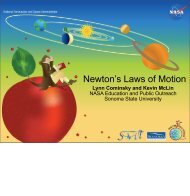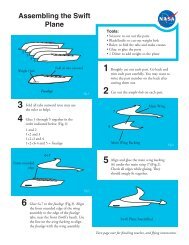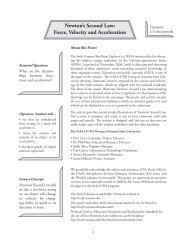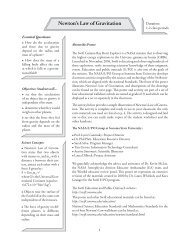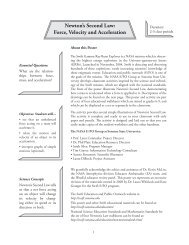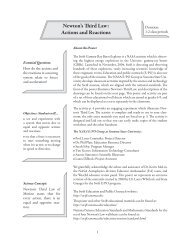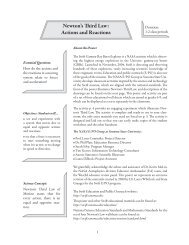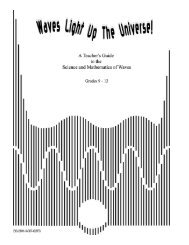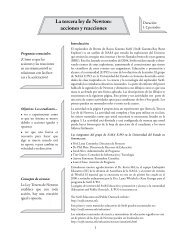Newton's First Law - Swift - Sonoma State University
Newton's First Law - Swift - Sonoma State University
Newton's First Law - Swift - Sonoma State University
- No tags were found...
You also want an ePaper? Increase the reach of your titles
YUMPU automatically turns print PDFs into web optimized ePapers that Google loves.
Question 8: This is why we use seat belts,to counteract that tendency to remainin motion. The seat belt applies a forceto a person that keeps them from flyingout of the car. Even better are air bags,which apply a smaller force to a personover a larger area than a seat belt, so theperson is protected in more areas thanjust the lap and shoulder.Do not try this at home!Question 9: When the car hits the wadded piece of paper, the paper is knocked away. This is because the car hasmore inertia than the paper, so the paper is easier to move. The force from the car is not enough to move the book,but it is easily enough to move the paper.Post-Activity Demonstration (Advanced students):A chunk of dry ice allowed to sit on the floor for a few minutes will get a flat surface underneath it as the warmfloor turns the dry ice into a gas. The chunk of dry ice will float on that gas, like an air hockey puck (see ExtensionActivity below). A small flick of the finger will cause the chunk to move in a straight line across the floor at aconstant speed. It is actually quite odd to see this, since we are used to friction (a force!) slowing things down.Warning: Dry ice is extremely cold, and can cause severe frostbite. If you perform this demo,follow safety procedures for dry ice (for example, http://www.abc.net.au/science/surfingscientist/pdf/lesson_plan08.pdf and http://www.school-for-champions.com/science/dry_ice.htm). Wear thickgloves, and don’t allow the students to touch the dry ice directly.Post-Activity (optional):Watch the demonstration of a chunk of “dry ice” moving across the floor. How does this illustrate Newton’s<strong>First</strong> <strong>Law</strong>?Extension Activity (Advanced students):When <strong>Swift</strong> launched on board the rocket, it was bolted to the rocket. A little over an hour after launch, at1:36 pm, the bolts holding it in place were cut. Then, 30 seconds later, the rocket fired “reverse thrusters” whichbacked it away from the <strong>Swift</strong> spacecraft. You can see the video of this, from a camera on-board the rocket, at:http://www.nasa.gov/mission_pages/swift/timeline/index.htmlHow does the motion of the <strong>Swift</strong> spacecraft in this video illustrate Newton’s <strong>First</strong> <strong>Law</strong>?For a more “down-to-Earth” example, go play air hockey. An air-hockey table is a good example of an almostfrictionless surface. Ask the students the following: Why does the puck stop when the air stops? What makesit frictionless? Would the puck go on forever if it could? (If the walls of the table didn’t stop it.) How is this anexample of Newton’s <strong>First</strong> <strong>Law</strong>?5
Post and Extension Activity Answers:When <strong>Swift</strong> was bolted inside the rocket’s nosecone, it continued to remain in motion in the same direction andwith the same speed as the rocket. When the bolts were retracted, no force was applied to either the rocket or<strong>Swift</strong>, so both continued to travel together in the same direction and at the same speed. When the rocket firedits reverse thrusters, an unbalanced force was applied to the rocket, but not to <strong>Swift</strong>. The rocket then movedaway from <strong>Swift</strong>, increasing their separation, letting <strong>Swift</strong> orbit freely around the Earth.The puck stops when the air stops because the friction on the puck becomes very large. The air cushion providesan almost frictionless surface, on which the puck will continue to move until it hits an obstruction like the edgeof the table. Of course, the air cushion is not perfectly frictionless, and if the table were very large, eventually thepuck would stop due to the small amount of friction that is present. This illustrates Newton’s <strong>First</strong> <strong>Law</strong> in showingthat an object in motion will continue that motion in a straight line when there are no unbalanced forcesacting on it. A chunk of dry ice floats on a cushion of gas in a similar manner.Assessment:Points43Sudden ImpactA) Student is able to correctly predict the motion of objects moving with andB) without friction, along a straight line. C) Student knows that inertia is thetendency of an object to resist a change in its motion. D) Student can correctlyidentify unbalanced forces and can predict the results of such forces.A) Student is able to predict the motion of objects moving with friction alonga straight line. B) Student can identify friction as an unbalanced force. C)Student knows that inertia is the tendency of an object to resist a change in itsmotion.2 Student achieves any two of the three objectives above.1 Student achieves one of the three objectives above.0 Student achieves none of the three objectives above.Materials:• A toy car, such as a matchbox car or anythinglike it that can roll• A toy figure of a person small enoughto sit on the car (a clay figure will work aswell)• A piece of cardboard or wood about ameter long to use as a ramp• Something on which to prop the ramp,such as a stack of books or the seat of achair• An object big and heavy enough to stopthe car from rolling, such as a book or ameter stick taped to the floorStack of booksRamp6The “littleguy”Book to stopthe carToy car
Student Handout:Inertia and Unbalanced ForcesThis activity will help you learn about Newton’s <strong>First</strong> <strong>Law</strong> of Motion. In this experiment youwill discover the properties of inertia and motion, and see how they have very important real-lifeapplications.Procedure: Sudden ImpactUse a separate sheet of paper to take notes and follow the instructions:1. Place the car on a flat, steady surface likea desk top. Place the figure of a person onthe car. Important: don’t press it down so itsticks; just let it rest there.2. Observe the car. Are there any forcesacting on it? What about the figure? DoesNewton’s <strong>First</strong> <strong>Law</strong> apply here? Write downyour thoughts.3. Place one end of the board on a stack ofbooks or the edge of a seat to create a ramp.Make sure there is plenty of room at thebase of the ramp for the car to roll.4. Using Newton’s <strong>First</strong> <strong>Law</strong>, predict whatwill happen when the car rolls down theramp and record this on your worksheet.5. Place the car and figure at the top of theramp. Let go, allowing the car and figureto roll down. Observe what happens, andrecord it.6. Now place a heavy object such as a booknear the bottom of the ramp, so that thecar will hit it. Again, using Newton’s <strong>First</strong><strong>Law</strong>, predict what will happen to the car,the figure, and the book when the car hitsthe book.7. Repeat the experiment above, againmaking sure the figure is placed on the car,not stuck on it. Record your observations.What happened to the book, the car, and thefigure? Were your predictions accurate?8. How is this experiment applicable in reallife? If you were a car designer, what kind offeature would you add to a car after performingthis experiment?9. Now replace the heavy book with a waddedup piece of paper, again making sure it is inthe path of the car. Using Newton’s <strong>First</strong><strong>Law</strong>, predict what will happen when the car,the figure, and the paper wad impact. Recordyour prediction.10. Repeat the experiment, recording yourobservations of the car, the figure, and thepaper wad. Was this situation different thanbefore? If so, what specifically was different,and why did this change the outcome of theexperiment? If nothing changed, why not?7
Example drawings that could represent the student’spredictions and/or observations for question 7.a. The small figure is not attached to the car as it rolls down the ramp.b. The small figure and the car accelerate down the ramp.c. At the bottom, the car is stopped by the stack of books, but the small figure continues to move.Ouch!8
References for all Four Posters:Copies of these materials, along with additional information on Newton’s <strong>Law</strong>s of Motion and <strong>Law</strong> ofGravitation, are available on the <strong>Swift</strong> Mission Education and Public Outreach Web site:http://swift.sonoma.edu/• NASA Web sites:NASA’s official Web site - http://www.nasa.gov<strong>Swift</strong> Satellite - http://swift.gsfc.nasa.gov• NASA Education Resources:The Space Place - http://spaceplace.nasa.govImagine the Universe! - http://imagine.gsfc.nasa.gov• NASA’s Central Operation of Resources for Educators (CORE):http://education.nasa.gov/edprograms/core/home/index.htmlCheck out these videos:“Liftoff to Learning: Newton in Space” (1992), $15.00“Flight Testing Newton’s <strong>Law</strong>s” (1999), $24.00• NASA’s Space Science Education Resource Directory:http://teachspacescience.org• Newton’s <strong>Law</strong>s of Motion:http://www-istp.gsfc.nasa.gov/stargaze/Snewton.htmhttp://www.grc.nasa.gov/WWW/K-12/airplane/newton.html• Newton’s <strong>Law</strong> of Gravitation:http://csep10.phys.utk.edu/astr161/lect/history/newtongrav.html• Newton in the Classroom:http://www.physicsclassroom.com/Class/newtlaws/newtltoc.htmlhttp://www.glenbrook.k12.il.us/gbssci/phys/Class/newtlaws/u2l1a.html• The Nine Planets:http://seds.lpl.arizona.edu/nineplanets/nineplanets/nineplanets.htmlhttp://seds.lpl.arizona.edu/nineplanets/nineplanets/data1.htmlhttp://swift.sonoma.edu



